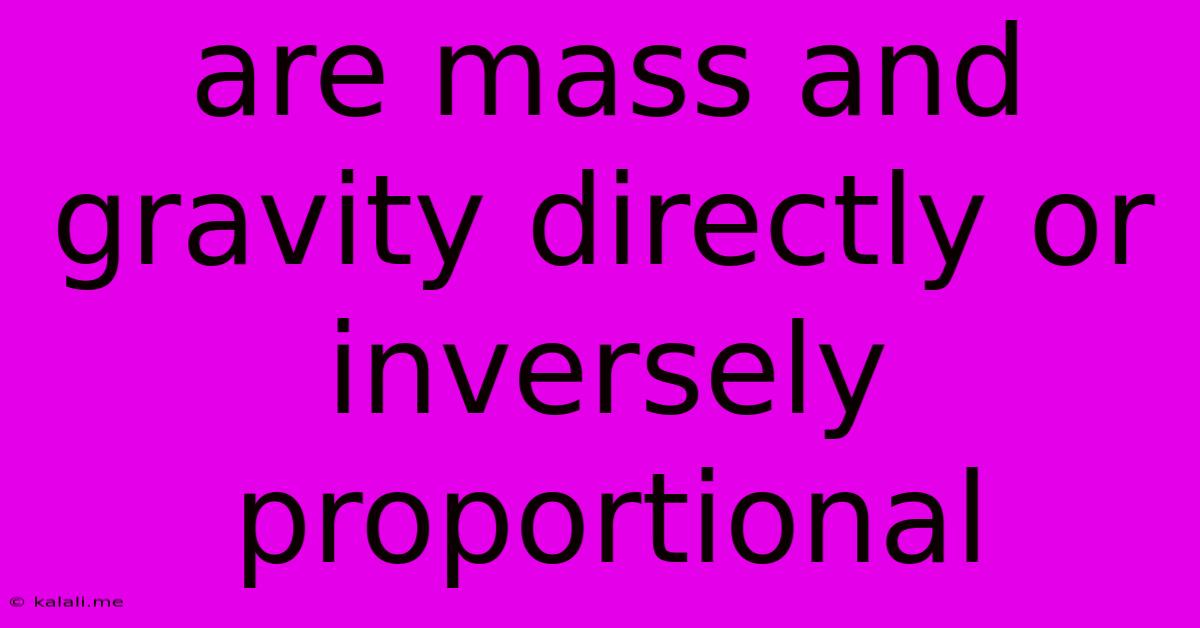Are Mass And Gravity Directly Or Inversely Proportional
Kalali
May 24, 2025 · 3 min read

Table of Contents
Are Mass and Gravity Directly or Inversely Proportional? Understanding Newton's Law of Universal Gravitation
The relationship between mass and gravity is a fundamental concept in physics, often explained through Newton's Law of Universal Gravitation. This article will explore this relationship, clarifying whether mass and gravity are directly or inversely proportional and explaining the implications of this relationship. Understanding this is crucial for comprehending a wide range of phenomena, from the orbits of planets to the tides on Earth.
Newton's Law of Universal Gravitation states that every particle attracts every other particle in the universe with a force which is directly proportional to the product of their masses and inversely proportional to the square of the distance between their centers. Let's break that down.
The Direct Proportionality of Mass and Gravitational Force
The crucial part for this article is the "directly proportional to the product of their masses" component. This means that if you double the mass of one object, the gravitational force between the two objects will also double. Similarly, if you triple the mass of one object, the gravitational force will triple. This holds true if you increase the mass of both objects; the gravitational force increases proportionally to the product of the masses.
In simpler terms: The more massive an object, the stronger its gravitational pull. A larger mass creates a stronger gravitational field. This is why planets with larger masses, like Jupiter, exert a stronger gravitational force than smaller planets, like Mars.
The Inverse Square Law: Distance's Role
While mass and gravity are directly proportional, the distance between the objects introduces an inverse square relationship. The gravitational force is inversely proportional to the square of the distance between the objects' centers. This means:
- Doubling the distance reduces the gravitational force to one-fourth (1/2²) its original strength.
- Tripling the distance reduces the gravitational force to one-ninth (1/3²) its original strength.
This inverse square relationship explains why gravitational force weakens rapidly as distance increases.
Mathematical Representation
The relationship is expressed mathematically as:
F = G * (m1 * m2) / r²
Where:
- F represents the gravitational force
- G is the gravitational constant (a fundamental constant in physics)
- m1 and m2 are the masses of the two objects
- r is the distance between the centers of the two objects
This equation clearly shows the direct proportionality to mass (m1 and m2) and the inverse square proportionality to distance (r²).
Implications and Examples
Understanding this direct proportionality between mass and gravity is essential for various applications:
- Orbital Mechanics: The mass of a planet dictates the strength of its gravitational pull, determining the orbital paths of its moons or satellites.
- Tidal Forces: The gravitational pull of the Moon (and to a lesser extent, the Sun) on Earth's oceans causes tides. The Moon's mass directly influences the strength of these tidal forces.
- Space Exploration: Calculating trajectories for spacecraft requires accurate estimations of gravitational forces, which are directly influenced by the masses of celestial bodies.
In conclusion, mass and gravity are directly proportional. An increase in mass leads to a directly proportional increase in gravitational force, holding distance constant. While distance plays a significant role through an inverse square relationship, the fundamental link between mass and the strength of gravity remains a direct one. This principle is a cornerstone of our understanding of the universe and its workings.
Latest Posts
Latest Posts
-
Cold Weather Hot Water Not Working
May 24, 2025
-
Why Does Explorer Exe Send Outbound Connections
May 24, 2025
-
What Distribution Is The Coat Hangers Problem Probability
May 24, 2025
-
Is It Okay Ro Remove Humanitarian Parole Stapled From Passport
May 24, 2025
-
Axe To Grind Or Ax To Grind
May 24, 2025
Related Post
Thank you for visiting our website which covers about Are Mass And Gravity Directly Or Inversely Proportional . We hope the information provided has been useful to you. Feel free to contact us if you have any questions or need further assistance. See you next time and don't miss to bookmark.